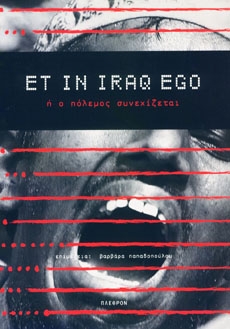
Et in Iraq ego
A three-faceted project with the participation of artists, theorists, and activists
· Workshop: A-STATION Athens Center for Contemporary Art, October 2003-February 2004
· Show: A-STATION Athens Center for Contemporary Art, June 2004
· Book Publication: Barbara Papadopoulou (ed.), Et in Iraq ego, or the war goes on, Athens: Plethron Publishing, 2004
Reflections on the War in Iraq six months after the beginning of the American led military operations.
Participants
Artists:
Mandy Albani
Anastasia Douka
Maria Lianou
Ioanna Myrka
Barbara Papadopoulou
Georgia Sagri
Despina Sevasti
Sofia Simaki
Andreas Sitorego
Eva Stefani
Giannis Theodoropoulos
Theorists - Essayists:
Athena Athanasiou – Social Anthropologist, Panteion University, Athens, Greece
Jimmy Efthymiou, Visual Artist-Musician
Stathis Gourgouris, Professor of Comparative Literature, Columbia University, NYC, USA
Polydoros Karyofyllis (Poka Yo), Visual Artist
Kostas Kalfopoulos, Sociologist and Political Scientist
Sotiris Kontogiannis, Activist
Pavlos Lefas, Architect, Professor of History and Theory of Architecture, University of Patras, Greece
Thanasis Moutsopoulos, Art Historian, Adjunct Professor of History of Art and Art Criticism, University of Crete, Greece
Neni Panourgia, Anthropologist, Columbia University, NYC, USA
Nikos Serdedakis, Sociologist, University of Crete, Greece
Manos Stefanidis, Art Historian and Critic, University of Athens, Greece
In April 2003, an unprecedented media storm hit the globe; for the first time ever, people around the world were offered the opportunity to watch a war in 24/7 live transmission. Six months later, in October 2003, it seemed that the time had come to reflect on the impact this new visual culture has had on “our” world. I set to organize and guide a project that included the set-up of a workshop, an exhibition, and the creation of a rather special book.
The core idea was that the war is a prime expression of culture, and that it mirrors the true but ever-changing identity of the communities involved in it; it is not just a sum of military deeds. The research focused on how our perception of the Iraq war was influenced by the way the news were reported; and on the impact the war has had on us and our political and moral constitution, keeping in mind that as members of the communities involved in the war, we all took part de facto in it.
The workshop, a 4 months long event which allowed artists and theorists to work together, elaborated on:
- the collateral realities of the war, such as: the anti-war movement; the shopping on the internet of war-related objects and services; the lives of people indirectly affected by the war (e.g.: an unidentified Iraqi immigrant who qeues at a telephone booth somewhere in Europe, waiting to find out if his loved ones back in Iraq are alive or dead).
- the blured distinction between friend and foe,
- the issue of memory and oblivion,
- the use of images as a medium for producing truth,
- and the boulimic consuption by the public of pictures portaying the pain of others.
The exhibition presented:
- the artworks that were produced during the 4 month-long workshop and as a result thereof;
- unedited documentary material of the visual culture associated with the war and its coverage by the media; this material was presented in an anti-spectacle manner to serve as critical commentary to the said visual culture
A series of public talks and round tables with prominent theorists (historians, art historians, social anthropologists, political analysts, journalists) addressed issues raised by the documentary material and the works presented at the exhibition
The book Et in Iraq ego, or the war goes on, Athens: Plethron Publishing, 2004, which in some sense condensed the whole project, consists of:
i. Reproductions of the artworks that were produced during the 4 month-long workshop and as a result thereof
ii. Essays by a wide spectrum of contributors such as political scientists, historians, social anthropologists, art historians
iii. Unedited documentary material of the visual culture associated with the war and its coverage by the media; the workshop was actually based on it; and against it is that the artworks produced and the essays written acquire their full meaning. Among them are to be found:
- extracts from the Archives of the Greek National Television labelled in an efficient but cruelly detached way (of the type: „nice footage of crying babies among rubble“),
- pictures of and commercials for mass-culture items, such as lighters adorned with Saddam’s pictures, and T-shirts with various war-related logos
- street-flyers calling for rallies and demonstrations against the war
- reprints of first pages of newspapers around the world (especially from African Nations) of the day Saddam Hussein was captured
- video stills of a live sports show broadcasted when news broke-in that American soldiers were hold captives by Iraqi forces (the sports show wasn’t interrupted: the producer split the screen into two halves, and relegated the sports show to the right hand-side of the screen to make room for the footage of the American captive soldiers shown on the left hand-side)
The title of the project "Et in Iraq ego" was inspired by the title of a famous painting by French painter N. Poussin (1594-1665).
Related Links (in Greek):
http://www.mic.gr/books.asp?id=25770
http://www.greekbooksinprint.gr/main.asp?page=results&key=et+in+iraq+ego
http://archive.enet.gr/online/online_text
/c=113,dt=16.06.2004,id=11042316